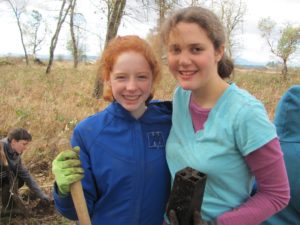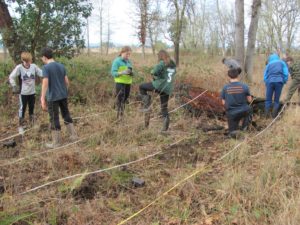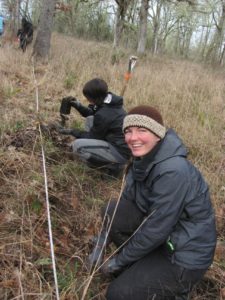
Students Love to Dig Holes for the Rare Thin-Leaved Peavine!
When middle school students from Eugene, Oregon were asked what they liked most about helping plant new populations of a rare plant, many enthusiastically replied, “digging holes is the best thing ever!” IAE’s Habitat Restoration and Ecological Education Programs teamed up on a project to not only teach students about a rare plant that occurs in and around their homes, but to give them the opportunity to participate in its restoration.
To give you some background, the Willamette Valley is home to some of the rarest plant communities in the Pacific Northwest: prairies and oak woodlands. The decline of these plant communities due to fire suppression, human development, and the introduction of invasive species has resulted in the decline of many of the plants, insects, and other animals that rely on these habitats. One of those species is the thin-leaved peavine (Lathyrus holochlorus). The thin-leaved peavine is a member of the pea family (Fabaceae). It is a rhizomatous, perennial and is currently recognized as a rare plant by the Bureau of Land Management, the U.S. Fish and Wildlife Service, and the Oregon Biodiversity Information Center. It is often found growing along roadsides, fence rows, and scattered amongst shrubs along the boundary between oak woodland and grass dominated prairies.
Between 2012 and 2014 IAE visited 90 previously recorded populations of the thin-leaved peavine throughout its historic range and were only able to relocate 53. Forty of those consisted of small populations with 100 stems or less. Since the thin-leaved peavine is a federal species of concern and even more rare than previously thought, we are working hard to increase the size and number of its populations to keep it off the endangered species list.


In order to prevent this species from continuing to decline, IAE developed a project where Willamette Valley students were given the opportunity to learn about the thin-leaved peavine both in the classroom, and in the field. In the classroom, Stacy Moore, Ecological Education Program Director, engaged students about the thin-leaved peavine by asking them what makes this species rare? And what can you and your family do to help rare plants? To the first question students gave thoughtful and accurate answers stating that fire suppression, invasive species, and humans’ alteration of the environment all contributed to the rarity of the thin-leaved peavine. For the second question, students talked about getting rid of invasive species and raising awareness of the existence of rare plants.
After the classroom lesson, students engaged in hands on activities. In 2017, middle schoolers at Oak Hill School in Eugene and high school students at College Hill School in Corvallis, scarified approximately 1500 seeds of the thin-leaved peavine and planted them into containers. In February of 2018, we planted 1000 in the ground: 400 by middle schoolers from Oak Hill School, 500 by high schoolers from College Hill School, and 100 by IAE staff. In May of 2018, students will return to their outplanting sites to monitor the survival of these plants.
In a world dominated by screens and technology, it’s wonderful to see students out in the field enthusiastically digging holes, engaging with the natural world, and making connections between factors that influence and effect rare plant population decline and recovery.
Thank you to Louisa Dorsch and Jim Luzzi at Oak Hill School and Cherie Taylor at College Hill School for participating in this project. Thank you to the West Eugene Wetlands Natural Resource Manager Sally Villegas and Bald Hill Land Steward Elizabeth Records for allowing your lands to be used as a classroom. And thank you to Ron Leonard for volunteering to help teach classroom sessions and keep order in the field.


Tags:
Restoration
Research
Education
Contact
Main Office:
4950 SW Hout Street
Corvallis, OR 97333-9598
541-753-3099
info@appliedeco.org
Southwest Office:
1202 Parkway Dr. Suite B
Santa Fe, NM 87507
(505) 490-4910
swprogram@appliedeco.org
© 2025 Institute for Applied Ecology | Privacy Policy
